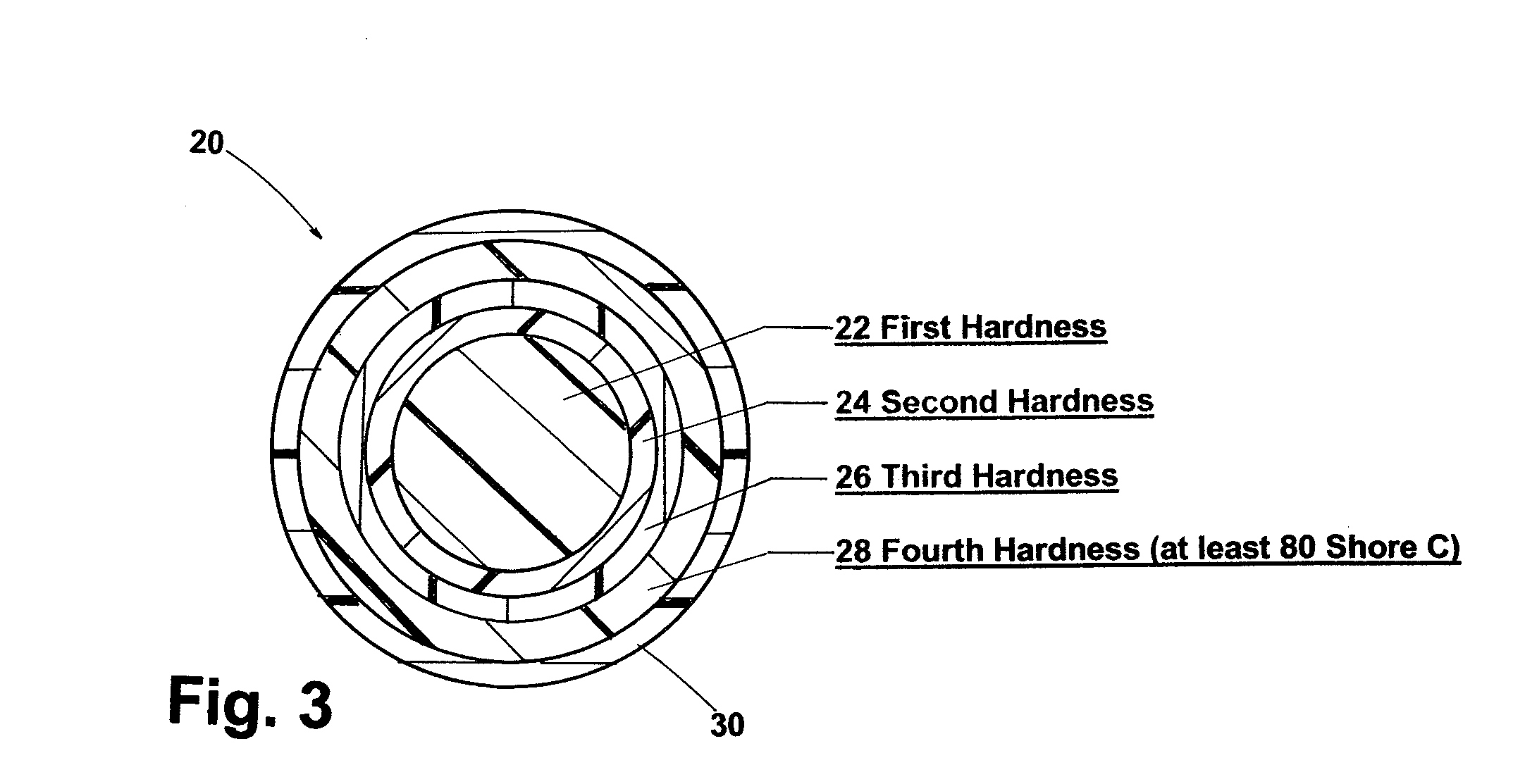Golf ball with heat resistant shield layer
a golf ball and shield layer technology, applied in golf balls, solid balls, sports equipment, etc., can solve the problems of recreational players who cannot intentionally control the spin of the ball, difficult control around the greens, and difficult to feel, so as to improve the playing characteristics of the golf ball, improve the melting point, and improve the effect of the golf ball
- Summary
- Abstract
- Description
- Claims
- Application Information
AI Technical Summary
Benefits of technology
Problems solved by technology
Method used
Image
Examples
##ic example 1
Prophetic Example 1
[0053]A golf ball 10, as shown in FIG. 1, has a 1.00 inch thermoplastic inner core 11 formed from HNP 2000 material (DuPont) which has a low vicat and a low melting point of less than 100° C., preferably a maximum of 75° C., and a Shore C surface hardness of less than 85 and a compression of less than 80; and a shield layer 12 of about 0.030 inch thick of Hytrel 4069 (DuPont), which is a high vicat thermoplastic composition having a vicat of at least 134° C. and a Shore D hardness of less than 65; a thermoset outer core layer 13 comprising of a peroxide cross-linked polybutadiene composition having a thickness of about 0.280 inch, a Shore C hardness of at least 80 and a specific gravity of greater than or equal to the shield layer 12; and, an ionomer, polyurethane or polyurea cover layer 14 having a thickness of about 0.030 inch, the cover layer 14 being either cast or reaction injection molded. The thermoset shield layer 12 has a vicat softening point temperature...
##ic example 2
Prophetic Example 2
[0054]As seen in FIG. 2, this example is the same as Example 1, except the ball further includes a thin inner cover layer 15 of Surlyn 7940, which is cast over the outer core layer 13. The thickness of the inner cover layer 15 is about 0.045 inch or less, and the outer core layer 13 is subsequently reduced by 0.02 inch. Surlyn 7940 comprises an ethylene / methacrylic acid copolymer in which the methacrylic acid groups have been partially neutralized with lithium ions and the vicat softening point is 63° C.
##ic example 3
Prophetic Example 3
[0055]Another embodiment of the invention is depicted in FIG. 3. A ball 20 includes an inner core 22 comprising of a thermoset polybutadiene composition and having a vicat of about 75° C. or less and having a first hardness. Encasing the inner core 22 is an intermediate layer 24 having a second hardness and comprising a partially or fully neutralized ionomer having a low vicat softening temperature. Surrounding the intermediate core layer 24 is a shield layer 26 comprising a thermoplastic material having a high vicat softening temperature of at least 80° C. and preferably 100° C., and the outer core layer having a third hardness. An outermost core layer 28 disposed over the shield layer 26 and comprising a thermoset polybutadiene composition having a fourth hardness of at least 80 Shore C and a specific gravity of at least 1.20 g / cc. The ball 20 has a cover layer 30 disposed over the outermost core layer 28. Not shown but the cover layer 30 may further be comprise...
PUM
| Property | Measurement | Unit |
|---|---|---|
| vicat softening point temperature | aaaaa | aaaaa |
| vicat softening point temperature | aaaaa | aaaaa |
| vicat softening point temperature | aaaaa | aaaaa |
Abstract
Description
Claims
Application Information
 Login to View More
Login to View More - R&D
- Intellectual Property
- Life Sciences
- Materials
- Tech Scout
- Unparalleled Data Quality
- Higher Quality Content
- 60% Fewer Hallucinations
Browse by: Latest US Patents, China's latest patents, Technical Efficacy Thesaurus, Application Domain, Technology Topic, Popular Technical Reports.
© 2025 PatSnap. All rights reserved.Legal|Privacy policy|Modern Slavery Act Transparency Statement|Sitemap|About US| Contact US: help@patsnap.com


